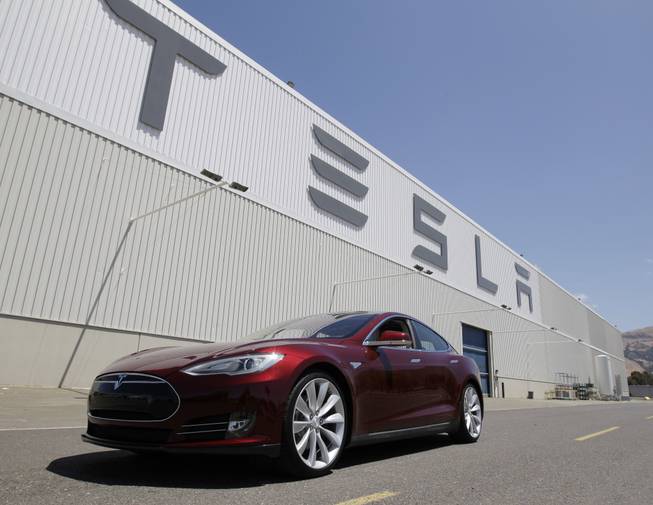
Paul Sakuma / AP
This June 22, 2012, photo shows a Tesla Model S electric sedan outside the Tesla factory in Fremont, Calif.
Sunday, Sept. 14, 2014 | 2 a.m.
Pros
• They are much lighter than other rechargeable batteries.
• They hold their charge much longer than other rechargeable batteries and can handle hundreds of charge/discharge cycles.
• They have no memory effect, meaning they don’t have to be completely discharged before use.
Cons
• They can burst into flames if the battery pack fails. That has been the cause of several spontaneous cell phone combustions.
• They are extremely sensitive to heat. High temperatures cause them to degrade much faster than a traditional battery.
• If they are completely discharged, they get ruined.
Now that Tesla Motors is poised to park its $5 billion lithium-ion battery plant near Reno, Nevadans may be wondering: What exactly is a lithium-ion battery, and how is it made?
Lithium batteries vs. traditional batteries
Lithium batteries are disposable and contain lithium as an anode; lithium-ion batteries use similar technology but are rechargeable. Both hold more power and last longer than traditional alkaline or zinc-carbon batteries.
As such, they commonly are used to power electronics (cellphones, cameras, laptops), high-performance equipment (electric cars, oceanography instruments) and electronic medical devices (thermometers, pacemakers).
They’re also more expensive. An 8-pack of Energizer Lithium AA batteries costs $31.09 at Staples, for example, while an 8-pack of Duracell AA alkaline batteries costs $8.99.
How do lithium batteries work?
All batteries have three parts — an anode, a cathode and an electrolyte. The cathode is the positive end, and the anode the negative end. Both are hooked up to an electrical circuit.
In lithium batteries, raw lithium, which is highly corrosive and requires special handling, is used to chemically create the cathode and anode inside a battery. Each side is divided by the electrolyte, a solvent that contains ions, and layered before being placed in a case. Once the cathode, anode and electrolyte are combined, a circuit is formed, and electricity is produced.
Lithium-ion batteries are rechargeable because they contain an electrolyte that allows lithium ions to move back and forth between the anode and the cathode.
How do lithium-ion batteries power an electric vehicle?
Powering a car without gas takes much more than a single battery. In fact, it requires thousands of them.
In a Tesla Model S, what looks like a single lithium-ion battery actually is made up of 7,000 smaller batteries sealed in a case. Each individual cell is slightly larger than a AA battery.
Traditional gas-fueled vehicles use a single battery filled with a paste of lead and diluted sulfuric acid.
Where does lithium come from?
Lithium is a soft, silver-white metal. More than 70 percent of the world’s supply comes from South America.
In Nevada, lithium is mined in Silver Peak, about 170 miles southeast of Tesla’s proposed battery factory and about 240 miles east of the company’s assembly plant in Fremont, Calif. Owned by Rockwood Lithium, a subsidiary of New Jersey-based Rockwood Holdings, it is the only operational lithium mining company in the country.
Aquifers in Silver Peak contain a greasy brine that is rich with mineral and metal salts that reduce in the sun to create a lithium carbonate powder called “concentrate.”
Other companies are working to find new ways to mine lithium. In Kings Valley, Reno developer Western Lithium is exploring a process that extracts lithium from clay known as hectorite.
Volcanic activity in Kings Valley 16 million to 27 million years ago caused a 450-square-mile piece of earth to collapse. It was heavy with erupted magma and left huge stores of hectorite.
To extract the lithium, Western Lithium roasts the hectorite in a machine that resembles a kiln to make the lithium water soluble. Then, workers combine the mixture with liquid chemicals to cause the lithium to separate from the clay, much the same way ores are leached for gold. The lithium then is processed and purified to prepare for market.
How much lithium does a Tesla use?
The battery of a Tesla Model S contains about 80 pounds of lithium. A cellphone battery, by comparison, uses about 1/10th of an ounce of lithium, while a Chevrolet Volt battery uses about 25 pounds.
How much do Tesla batteries cost?
Upward of $10,000 for each vehicle. Batteries are the most expensive component of a Tesla.
But the lithium-ion batteries are said to last at least twice as long as a traditional car battery, which cost about $100 and lasts an average of about four years.
Tesla offers an eight-year battery warranty on its Model S.

Join the Discussion:
Check this out for a full explanation of our conversion to the LiveFyre commenting system and instructions on how to sign up for an account.
Full comments policy